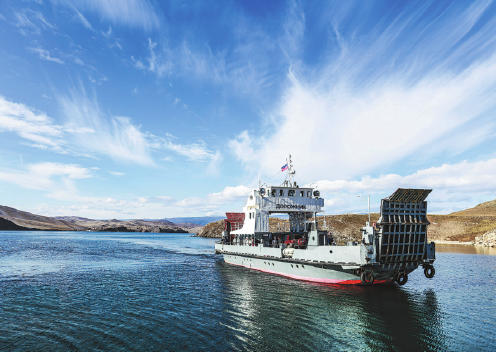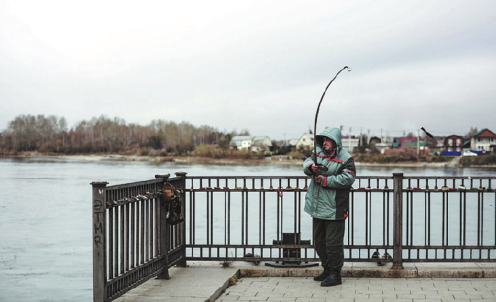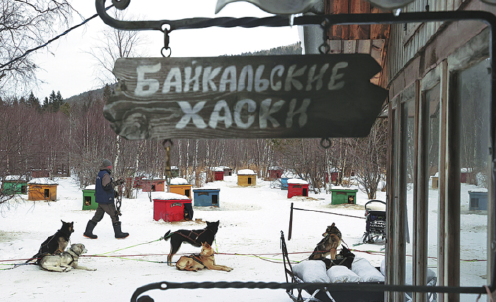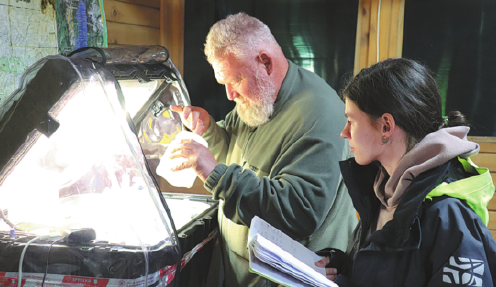Lake's unique beauty entices global travelers
Pristine waters and awe-inspiring landscapes offer tourists unforgettable experiences

Described as the Pearl of Siberia, Lake Baikal in Russia is the largest freshwater lake in the world and one of the most popular travel destinations for both tourists and photographers.
The lake is in a rift valley, created by the Baikal Rift Zone, where the Earth's crust is slowly pulling apart. It is also the deepest lake in the world at 1,642 meters.
The lake's age is estimated to be 25 to 30 million years, making it the most ancient lake in geological history. It is unique among large, high-latitude lakes, as its sediments have not been scoured by overriding continental ice sheets.
Baikal is one of the clearest lakes in the world. During the winter, the water transparency in open sections can be as much as 30 to 40 meters. The lake is rich in oxygen, even in deeper sections, which separates it from distinctly stratified bodies of water such as Lake Tanganyika and the Black Sea.
While more than 300 rivers flow into Baikal, only one-the Angara-flows out, eventually draining into the Arctic Ocean, hundreds of kilometers to the north.
"The Sacred Sea"
Alongside being blessed with staggering biodiversity, the lake is also known as the Sacred Sea, inspiring many myths. Among the local legends is that of a water beast, named LusudKhan (Water Dragon Master) by the region's indigenous Buryat people.
The legendary lake monster is said to resemble a giant sturgeon, with a protruding snout and armor festooning its back. Some suggest that it is represented in the Stone Age petroglyphs located along the Baikal cliffs.
Set deep within the Russian subcontinent, Baikal is the deepest and most voluminous of all lakes, a superstar of superlatives in hydrology, geology, ecology and history.
Today, the lake contains some 20 percent of the Earth's lake and river water, making this Russian giant comparable in volume to the entire Amazon basin.
The lake is rich in biodiversity, and supports more than 2,500 animal species, about 80 percent of which live nowhere else on the planet.
The most famous of these animals may be the Baikal seal, the only exclusively freshwater seal on the planet. Numbering an estimated 100,000, the presence of this comfortable and well-adapted population of animals in interior Russia has stumped evolutionary biologists, who aren't certain just when or how the animals came to be so far from the open ocean.
The Baikal area, sometimes known as Baikalia, has a long history of human habitation.
Near the village of Mal'ta, some 160 km northwest of the lake, remains of a young human male known as MA-1 or "Mal'ta Boy" are indications of local habitation by the Mal'ta-Buret' culture around 24,000 years ago. An early tribe known in the area was the Kurykans.
The first European to visit Lake Baikal may have been recorded as Russian explorer Kurbat Ivanov in 1643.
Flourishing tourism
Today, a wilderness of forest, plains and semidesert surround Baikal in the grand landscape of Siberia, though development along the shores of the lake occurred last century with the building of several urban and resort communities.
Every year the lake attracts travelers from all over the world. The village of Listvyanka is the most popular location. Lying on the southeast coast of the lake, Listvyanka is located 70 km from Irkutsk and is at the point where the Angara River leaves the lake.
This quaint village has approximately 1500 inhabitants and stretches over 5 km in an arc along the coast. Its tourist infrastructure is developing faster than anywhere else in Siberia due to its popularity among global visitors.
The ever-growing trail network links Listvyanka with Bolshiye Koty, another of the stunning fishing villages along the shore. The 24 km trail can be finished within 5-8 hours.
The hike along the route usually takes 2-3 days and is characterized by swift transitions between steep coastal bluffs, sandy beaches and deep forests. There are guesthouses and homestays available at villages for the night, and visitors can get back to Irkutsk by boat or bus from the trail's end in Bolshoye Goloustnoye.
Despite threats from oil pipelines and other human activity, Lake Baikal remains largely pristine, its ecology insulated from environmental degradation by its sheer immensity and farflung location.
But local conservationists have causes for concern.
"For the most part, microplastics are found in the surface layer of Baikal water in the southeast and western coast of the lake. These areas are the most packed with tourists and locals. In the samples taken by scientists, most of the microplastics reach sizes of 3 to 5 millimeters. This degradable plastic is not amenable to further processing," said Ruslan Gubaidullin, head of the Clean Country Association.
Organized by En+ Group together with the Lomonosov Moscow State University, the expedition for the monitoring of the ecological state of Lake Baikal was carried out for years, aimed at determining the actual risks and threats to the lake created by anthropogenic load, technology-related factors and natural processes.
Mikhail Kolobov, the scientific team leader and senior researcher at the Department of Hydrobiology of Lomonosov Moscow State University, told China Daily that recently the concentration of microplastics in Baikal has been growing by 50 percent annually. At the same time, the level of pollution at the lake will continue to grow due to the ever-increasing interest of tourists.
The popularity of Baikal is steadily growing. From last year, tourists were able to receive information about the handling of garbage along the entire route.
Replacing plastic
Today, Lake Baikal has become a zone where it is possible and necessary to implement projects to replace plastic. Scientists suggest using composite materials instead. As legislative initiatives are worked out and new materials are tested, this innovative policy can be scaled to all protected areas in Russia, Kolobov said.
The gateway to the lake is the city of Irkutsk, a stop on the famed Trans-Siberian Railway, which many visitors on relaxed schedules use to arrive and depart. But still, the city itself worth a visit for a day or two.
Irkutsk is the largest city in Siberia with a population of over 600,000. There's 19th-century architecture, stunning churches and great places to eat in the city.
Irkutsk's weather in winter sees temperatures of around -20 C. The weather gets cold enough in this region to make Lake Baikal the most impressive frozen lake in Russia.
The city is full of beautiful and extravagantly decorated orthodox churches. Krestovozdvizhenskaya Tserkov' and Spasskaya Tserkov' are two churches especially worth a visit.
Another top attraction is the Central Market. This huge market sells everything from fresh fruits and vegetables to clothes.
The symbol of Irkutsk is the Babr which is an old Russian word meaning 'Siberian Tiger'. The tiger has been on the city's coat of arms since Irkutsk was established in the 17th century. There's a sculpture of the Babr in a small square by Lenina Street.





Today's Top News
- Tajikistan looks to China for deeper ties
- High-tech manufacturing lifts industrial profits
- Avenue blooms with flowers to mark victory
- Mainland slams DPP for distorting WWII history
- Northeast Asia trade in focus at Jilin expo
- Organic agriculture forum unites global experts in Datong






























